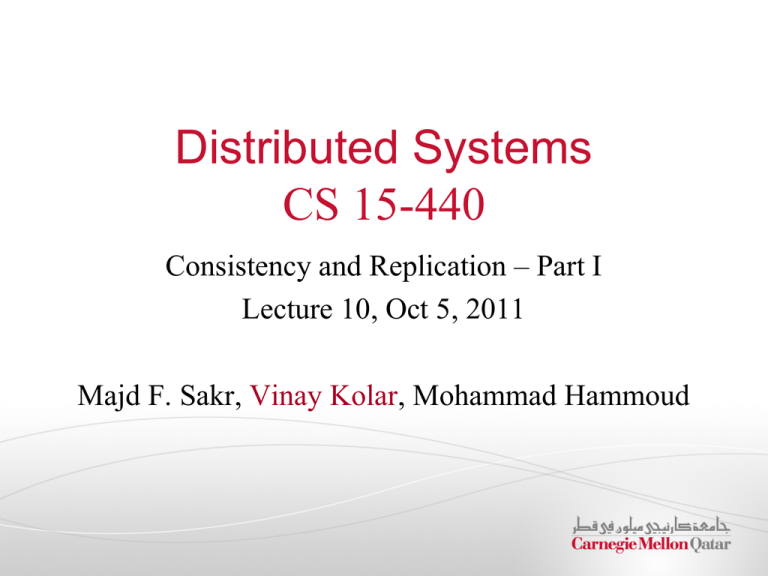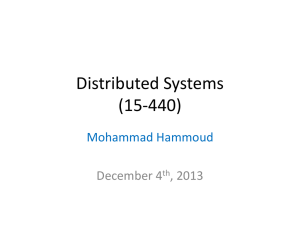Slide 1
advertisement

Distributed Systems CS 15-440 Consistency and Replication – Part I Lecture 10, Oct 5, 2011 Majd F. Sakr, Vinay Kolar, Mohammad Hammoud Today… Last Session Synchronization: Mutual Exclusion and Election Algorithms Today’s session Consistency and Replication New Chapter Introduction Data-centric and Client-Centric Consistency Models Announcement Project 2 is out. Interim Design report due on Oct 10th 2 Why Replication? Replication is the process of maintaining the data at multiple computers Replication is necessary for: 1. Improving performance A client can access the replicated copy of the data that is near to its location 2. Increasing the availability of services Replication can mask failures such as server crashes and network disconnection 3. Enhancing the scalability of the system Requests to the data can be distributed to many servers which contain replicated copies of the data 4. Securing against malicious attacks Even if some replicas are malicious, secure data can be guaranteed to the client by relying on the replicated copies at the non-compromised servers 3 1. Replication for Improving Performance Example Applications Caching webpages at the client browser Caching IP addresses at clients and DNS Name Servers Caching in Content Delivery Network (CDNs) Commonly accessed contents, such as software and streaming media, are cached at various network locations Main Server Replicated Servers 4 2. Replication for High-Availability Availability can be increased by storing the data at replicated locations (instead of storing one copy of the data at a server) Example: Google File-System and Chubby replicate the data at computers across different racks, clusters and data-centers If one computer or a rack or a cluster crashes, then the data can still be accessed from another source 5 3. Replication for Enhancing Scalability Distributing the data across replicated servers helps in avoiding bottle-necks at the main server It balances the load between the main and the replicated servers Example: Content Delivery Networks decrease the load on main servers of the website Main Server Replicated Servers 6 4. Replication for Securing Against Malicious Attacks If a minority of the servers that hold the data are malicious, the nonmalicious servers can outvote the malicious servers, thus providing security. The technique can also be used to provide fault-tolerance against non-malicious but faulty servers Example: In a peer-to-peer system, peers can coordinate to prevent delivering faulty data to the requester 1 2 5 4 Number of servers with correct data outvote the faulty servers 6 0 3 7 n = Servers that do not have the requested data n = Servers with correct data n = Servers with faulty data 7 Why Consistency? In a DS with replicated data, one of the main problems is keeping the data consistent An example: In an e-commerce application, the bank database has been replicated across two servers Maintaining consistency of replicated data is a challenge Event 1 = Add $1000 Event 2 = Add interest of 5% 2 1 Bal=2000 Bal=2100 Bal=1000 4 3 Bal=1000 Bal=1050 Bal=2050 Replicated Database 8 Overview of Consistency and Replication Today’s lecture Consistency Models Data-Centric Consistency Models Client-Centric Consistency Models Replica Management When, where and by whom replicas should be placed? Which consistency model to use for keeping replicas consistent? Consistency Protocols We study various implementations of consistency models Next lectures 9 Overview Consistency Models Data-Centric Consistency Models Client-Centric Consistency Models Replica Management Consistency Protocols 10 Introduction to Consistency and Replication In a distributed system, shared data is typically stored in distributed shared memory, distributed databases or distributed file systems. The storage can be distributed across multiple computers Simply, we refer to a series of such data storage units as data-stores Multiple processes can access shared data by accessing any replica on the data-store Processes generally perform read and write operations on the replicas Process 1 Process 2 Process 3 Local Copy Distributed data-store Maintaining Consistency of Replicated Data DATA-STORE Process 1 R(x)0 Process 2 Process 3 R(x)0 Replica 1 Replica 2 Replica 3 Replica n x=0 x=2 x=5 x=2 x=5 x=0 x=0 x=5 x=2 x=0 x=5 x=2 W(x)2 R(x)5 R(x)? R(x)2 R(x)? W(x)5 Strict Consistency • Data is always fresh • After a write operation, the update is propagated to all the replicas • A read operation will result in reading the most recent write • If there are occassional writes and reads, this leads to large overheads P1 =Process P1 =Timeline at P1 R(x)b =Read variable x; Result is b 12 W(x)b = Write variable x; Result is b Maintaining Consistency of Replicated Data (cont’d) DATA-STORE Process 1 R(x)0 Process 2 Process 3 R(x)5 Replica 1 Replica 2 Replica 3 Replica n x=0 x=2 x=0 x=2 x=0 x=5 x=2 x=0 x=3 x=2 W(x)2 R(x)5 R(x)? R(x)3 R(x)? W(x)5 Loose Consistency • Data might be stale • A read operation may result in reading a value that was written long back • Replicas are generally out-of-sync • The replicas may sync at coarse grained time, thus reducing the overhead P1 =Process P1 =Timeline at P1 R(x)b =Read variable x; Result is b 13 W(x)b = Write variable x; Result is b Trade-offs in Maintaining Consistency Maintaining consistency should balance between the strictness of consistency versus efficiency Good-enough consistency depends on your application Loose Consistency Easier to implement, and is efficient Strict Consistency Generally hard to implement, and is inefficient 14 Consistency Model A consistency model is a contract between the process that wants to use the data, and the replicated data repository (or data-store) A consistency model states the level of consistency provided by the data-store to the processes while reading and writing the data 15 Types of Consistency Models Consistency models can be divided into two types: Data-Centric Consistency Models These models define how the data updates are propagated across the replicas to keep them consistent Client-Centric Consistency Models These models assume that clients connect to different replicas at each time The models ensure that whenever a client connects to a replica, the replica is bought up to date with the replica that the client accessed previously 16 Overview Consistency Models Data-Centric Consistency Models Client-Centric Consistency Models Replica Management Consistency Protocols 17 Data-centric Consistency Models Data-centric Consistency Models describe how the replicated data is kept consistent, and what the process can expect Under Data-centric Consistency Models, we study two types of models: Consistency Specification Models: These models enable specifying the consistency levels that are tolerable to the application Models for Consistent Ordering of Operations: These models specify the order in which the data updates are propagated to different replicas 18 Overview Consistency Models Data-Centric Consistency Models Consistency Specification Models Models for Consistent Ordering of Operations Client-Centric Consistency Models Replica Management Consistency Protocols 19 Consistency Specification Models In replicated data-stores, there should be a mechanism to: Measure how inconsistent the data might be on different replicas How replicas and applications can specify the tolerable inconsistency levels Consistency Specification Models enable measuring and specifying the level of inconsistency in a replicated data-store We study a Consistency Specification Model called Continuous Consistency Model 20 Continuous Consistency Model Continuous Consistency Model is used to measure inconsistencies and express what inconsistencies can be expected in the system Yu and Vahdat [1] provided a framework for measuring and expressing consistency in replicated data-stores 21 Continuous Consistency Ranges Level of consistency is defined over three independent axes: Numerical Deviation: Deviation in the numerical values between replicas Order Deviation: Deviation with respect to the ordering of update operations Staleness Deviation: Deviation in the staleness between replicas Numerical Deviation Example: Two copies a stock price should not deviate by more than $0.02 Example: Weather data should not be more than four hours stale Staleness Deviation Example: In a bulletin board application, a maximum of six messages can be issued out-of-order Ordering Deviation 22 Consistency Unit (Conit) Consistency unit (Conit) specifies the data unit over which consistency is measured For example, conit can be defined as a record representing a single stock Level of consistency is measured by each replica along the three dimensions Numerical Deviation For a given replica R, how many updates at other replicas are not yet seen at R? What is the effect of the non-propagated updates on local Conit values? Order Deviation For a given replica R, how many local updates are not propagated to other replicas? Staleness Deviation For a given replica R, how long has it been since updates were propagated? 23 Example of Conit and Consistency Measures Order Deviation at a replica R is the number of operations in R that are not present at the other replicas Replica A Numerical Deviation at replica R is defined as n(w), where n = # of operations at other replicas that are not yet seen by R, w = weight of the deviation = max(update amount of all variables in a Conit) Replica A x y VC Ord Num x y VC Ord Num 0 (0,0) 0 0(0) 0 0 (0,0) 0 0(0) 0 0 (0,0) 0 1(2) 2 0 (0,5) 1 0(0) 2 0 (1,5) 0 0(0) 2 0 (0,5) 0 0(0) 2 1 (10,5) 1 0(0) 2 0 (0,5) 0 1(1) 2 1 (10,5) 1 1(1) 2 1 (0,16) 1 1(1) 3 1 (14,5) 2 1(1) 2 1 (0,16) 1 2(2) 3 4 (23,5) 3 1(1) 2 1 (0,16) 1 3(4) Operation performed at B when the vector clock was 5 <m,n> = Uncommitted operation <m,n> Result Operation Replica B 0 <5,B> = x; y <5,B> <10,A> x+=2 y+=1 x=2 y=1 <14,A> <23,A> x+=1 y+=3 x=3 y=4 Replica B x; y Result Operation <5,B> <16,B> = Committed 24 operation x+=2 y+=1 x;y x=2 y=1 = A Conit Overview Consistency Models Data-Centric Consistency Models Continuous Specification Models Models for Consistent Ordering of Operations Client-Centric Consistency Models Replica Management Consistency Protocols 25 Why is Consistent Ordering Required in Replication? In several applications, the order or the sequence in which the replicas commit to the data store is critical Example: Event 1 = Add $1000 Event 2 = Add interest of 5% 2 1 3 4 Bal=2000 Bal=2100 Bal=1000 Replicated Databases Bal=1000 Bal=1050 Bal=2050 Continuous Specification Models defined how inconsistency is measured However, the models did not enforce any order in which the data is committed 26 Consistent Ordering of Operations (cont’d) Whenever a replica is updated, it propagates the updates to other replicas at some point in time Updating different replicas is carried out by passing messages between the replica data-stores We will study different types of ordering and consistency models arising from these orderings 27 Types of Ordering We will study three types of ordering of messages that meet the needs of different applications: 1. Total Ordering 2. Sequential Ordering i. Sequential Consistency Model 3. Causal Ordering i. Causal Consistency Model 28 Types of Ordering 1. Total Ordering 2. Sequential Ordering 3. Causal Ordering 29 Total Ordering Total Order If process Pi sends a message mi and Pj sends mj, and if one correct process delivers mi before mj then every correct process delivers mi before mj P1 P2 P3 m(1,1) m(3,1) Ex1: Total Order Messages can contain replica updates, such as passing the read or write operation that needs to be performed at each replica In the example Ex1, if P1 issues the operation m(1,1): x=x+1; and If P3 issues m(3,1): print(x); Then, at all replicas P1, P2, P3 the following order of operations are executed print(x); x=x+1; P1 P2 P3 m(1,1) Ex2: Not in Total Order m(3,1) Types of Ordering 1. Total Ordering 2. Sequential Ordering 3. Causal Ordering 31 Sequential Ordering If a process Pi sends a sequence of messages m(i,1),....,m(i,ni), and Process Pj sends a sequence of messages m(j,1),....,m(j,nj), P1 P2 P3 m(1,1) m(3,1) m(3,2) m(1,2) m(3,3) Then, : At any process, the set of messages received are in some sequential order Messages from each individual process appear in this sequence in the order sent by the sender At every process, mi,1 should be delivered before mi,2 , which is delivered before mi,3 and so on... At every process, mj,1 should be delivered before mj,2 , which is delivered before mj,3 and so on... Valid Sequential Orders P1 P2 P3 m(1,1) m(3,1) m(3,2) m(1,2) m(3,3) Invalid Sequential Orders, but Valid Total Order Sequential Consistency Model Sequential Consistency Model enforces that all the update operations are executed at the replicas in a sequential order Consider a data-store with variable x (Initialized to NULL) In the two data-stores below, identify the sequentially consistent data-store P1 P2 P1 W(x)a W(x)b P3 P2 R(x)b R(x)a P4 R(x)a P3 R(x)b P4 (a) Results while operating on DATA-STORE-1 P1 =Process P1 =Timeline at P1 W(x)a W(x)b R(x)a R(x)b R(x)b R(x)a (b) Results while operating on DATA-STORE-2 R(x)b =Read variable x; Result is b 33W(x)b = Write variable x; Result is b Sequential Consistency (cont’d) Consider three processes P1, P2 and P3 executing multiple instructions on three shared variables x, y and z Assume that x, y and z are set to zero at start P1 P2 P3 x = 1 print (y,z) y = 1 print (x,z) z = 1 print (x,y) There are many valid sequences in which operations can be executed at the replica respecting sequential consistency Identify the output x = 1 print (y,z) y = 1 print (x,z) z = 1 print (x,y) Output 001011 x = 1 y = 1 print (x,z) print (y,z) z = 1 print (x,y) 101011 z = 1 print (x,y) print (x,z) y = 1 x = 1 print (y,z) 000111 y = 1 z = 1 print (x,y) print (x,z) x = 1 print (y,z) 010111 34 Implications of Adopting Sequential Consistency Model for Applications There might be several different sequentially consistent combinations of ordering Number of combinations for a total of n instructions = 𝑂(𝑛!) The contract between the process and the distributed data-store is that the process must accept all of the sequential orderings as valid results A process that works for some of the sequential orderings and does not work correctly for others is INCORRECT 35 Summary Replication is necessary for improving performance, scalability and availability, and for providing fault-tolerance Replicated data-stores should be designed after carefully evaluating the trade-off between tolerable data inconsistency and efficiency Consistency Models describe the contract between the data-store and process about what form of consistency to expect from the system Data-centric consistency models: Continuous Consistency Models provide mechanisms to measure and specify inconsistencies Consistency Models can be defined based on the type of ordering of operations that the replica guarantees the applications We studied Sequential Consistency Model 36 Next Classes Consistency Models Data-Centric Consistency Model: Causal Consistency Model Client-Centric Consistency Models Replica Management Replica management studies: when, where and by whom replicas should be placed which consistency model to use for keeping replicas consistent Consistency Protocols We study various implementations of consistency models 37 References [1] Haifeng Yu and Amin Vahdat, “Design and evaluation of a conit-based continuous consistency model for replicated services” [2] http://tech.amikelive.com/node-285/using-content-delivery-networks-cdn-to-speed-up-contentload-on-the-web/ [3] http://en.wikipedia.org/wiki/Replication_(computer_science) [4] http://en.wikipedia.org/wiki/Content_delivery_network [5] http://www.cdk5.net [6] http://www.dis.uniroma1.it/~baldoni/ordered%2520communication%25202008.ppt [7] http://www.cs.uiuc.edu/class/fa09/cs425/L5tmp.ppt 38








